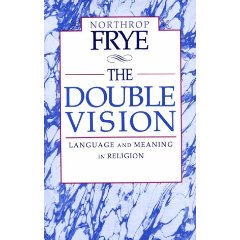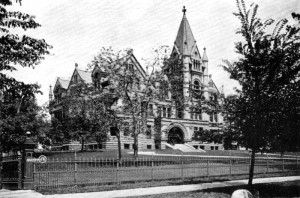
For students and aficionados alike, a point-by-point outline of The Double Vision.
Preface. Frye remarks on the incompleteness of the total argument in The Double Vision after three chapters and his decision to add a fourth. Why only “after considerable hesitation”?
I. The Double Vision of Language
[Autobiographical element: Methodist emphasis on experience and exposure to Biblical narrative: conditioning factors in a literary criticism that focuses on story and vision (3)]
A. The Whirligig of Time, 1925-90:
1. Myths = the functional units of human society. Before the Depression years, capitalism was St. George who had triumphed over Marxism; mid-thirties, socialism (or communism) was St. George and fascism was the dragon; today, capitalism democracies are St. George and communism is the dragon.
2. Similar whirligig in Hegelian and Marxist notions of conflict: Hegel = conflict of ideas leading to ultimate goal of freedom; Marx = class conflict and struggle over means of production. Today, Hegelian thrust for freedom being revived.
3. Cyclical rhythm of history produces different myths of freedom, but these are secondary myths or ideologies that don’t result in genuine freedom, which comes from primary, not secondary concern.
B. Primitive & Mature Societies:
1. Primary concerns = food, sex, property, freedom; secondary concerns = political & religious ideologies. Western democracies have been better at fulfilling the needs that spring from primary concerns, but McCarthyism, American imperialism, etc. show that something is still needed, something beyond the material: the spiritual.
2. The difference between the spiritual aspect of primary concerns and ideology or secondary concerns can be seen in the difference between primitive & mature societies:
a. Primitive societies: hierarchical; individual subordinated to the group
b. Mature societies: group functions to create genuine individuality (an “individualized society”); mature societies contain spiritual people: soma pneumatikon (spiritual body), rather than soma psychikon (natural body)
C. The Crisis in Language: the difference between ideological & spiritual concern is a difference in language
1. Descriptive or demonic literalism: descriptive accuracy, logical argument, ideological, creedal dogma
2. Imaginative literalism: counter-historical, counter-logical language of myth, metaphor, paradox, interpenetrative, open, kerygmatic vision. Imaginative literalism is a key point in Frye. For whatever else it is, the New Testament is written in literary language. “The literary language of the New Testament is not intended, like literature itself, simply to suspend judgment, but to convey a vision of spiritual life that continues to transform and expand our own. That is, its myths become, as purely literary myths cannot, myths to live by; its metaphors become, as purely literary metaphors cannot, metaphors to live in” (17-18). Kerygma or proclamation.
Key concept: interpenetration: here (p. 18) defined as “the free flowing of spiritual life into and out of one another that communicates but never violates.” See also the beginning of chapter 3, where Frye, drawing on Whitehead, sees interpenetration as “spiritual vision.”
The language of spirit is the language of love.
